The ancient world knew of planets – the five wandering stars that moved with respect to the background stars. The invention of the telescope allowed Galileo to discover that Jupiter had moons – proving that not everything orbits Earth. This led to the realization that Earth is also a planet, and that the six planets orbit the sun. It didn’t seem to occur to most astronomers that the solar system might have other planets – those too distant and too faint to be detected be the unaided eye. This changed in the year 1781 with the discovery of the planet Uranus.
The Discovery
William Herschel (1738-1822) was an astronomer and music composer. He was also masterful at building mirrors for reflecting telescopes, which he sold for profit, sometimes also building and selling the entire telescope.[1] He had constructed his own 6.2-inch Newtonian, a very high-quality telescope for the time. (Today you can purchase a similarly-sized telescope for around $300 on the internet). He used his telescope to explore the heavens, and began keeping a journal of his observations in 1774. Herschel specialized in observations of double stars – stars which appear very close together even when viewed in a telescope.[2] He catalogued hundreds of binary stars, as well as nebulae and star clusters. But his greatest discovery was serendipitous. In March, 1781, he spotted in his telescope a very small, light-blue disk.
Since no one was thinking that there could possibly be other planets besides the six that were already known, Herschel did not realize the nature of his discovery at first. He knew that this object was unusual. It didn’t look like a typical star. In a telescope, stars appear as points of light with no apparent size except for the glare surrounding them. This new object was clearly a disk; very small, but still noticeably larger than a point. Herschel suspected he might be seeing the actual disk of a particularly large or nearby star – either that, or a comet.
Herschel’s follow-up observations revealed that this object slowly changed its position relative to the background stars from night to night. So it couldn’t be a star. Yet, the object did not have a visible coma – the cloud that typically surrounds a comet. Nor did it have a tail. Further observations revealed that this object did not move the way comets typically do. Comets tend to have elliptical orbits with high eccentricity and inclinations. But this new disk was moving in a nearly circular path and in the same plane as the planets. It was clearly a planet – one far beyond Saturn and unknown to the ancient world.
But what to name it? The other five planets (not including Earth) had been known from antiquity and were named after Roman deities. Herschel decided that this new planet should reflect the times. He wanted to name it Georgium Sidus (George’s Star) after King George III who was in power at the time. Herschel reasoned that this would reflect the time that the planet was discovered. Understandably, this pleased the king, but the suggested name was not favored outside of Britain. The French, in particular, refused the suggestion and opted to call the new planet Herschel after its discoverer. Several other names were suggested, including Neptune.
But tradition prevailed and the planet was named after the pagan god Uranus. But there is a twist: Uranus is the (Latinized) name of a Greek god, whereas all the other planets are named after Roman gods. The name seemed fitting in a number of ways. In Greek mythology, Uranus was the god of the sky, which fits the lovely sky-blue color of this new planet. Furthermore, Uranus was the father of Cronos (the Greek equivalent of Saturn) who was the father of Zeus (the Greek equivalent of Jupiter). And the name avoided any political implications. It took several decades for this name to become universally accepted.
Orbital and Physical Properties
Uranus orbits the sun at a distance of 1.79 billion miles – that’s over twice the distance of Saturn, and nineteen times the distance between the sun and Earth. It takes 84 years to complete an orbit. Like all planets, it orbits the sun prograde (counter-clockwise as viewed from over the sun’s north pole), and in approximately the same plane as the other planets. Uranus is four times the size of Earth in diameter. And so even at its great distance, it is large enough to reflect sufficient sunlight to be easily seen in a small telescope, and even in binoculars. In fact, the brightness of Uranus is near the limit of naked-eye visibility. So, at the right time of year, Uranus can be seen (barely) with the unaided eye under extremely dark skies.
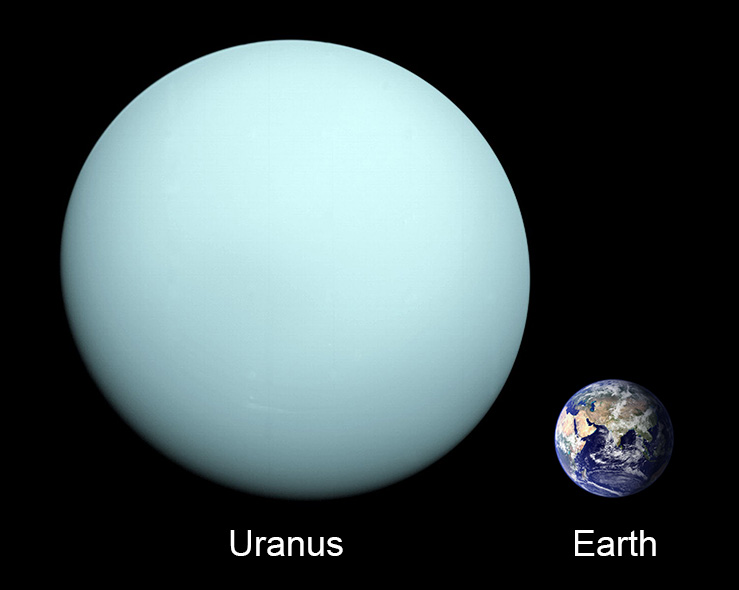
Even a modest backyard telescope will reveal the sky-blue color of Uranus. With a six-inch (diameter mirror) or larger telescope, at 200x or greater magnification, you can distinctly see that Uranus has size. It really does appear as a little blue disk and not like a star. You can even see limb-darkening; the circumference of the disk appears darker than the center due to the way sunlight reflects. With larger telescopes, white weather patterns can often be seen on the planet.
Uranus is sometimes classified as a Jovian or gas-giant planet. But more commonly in recent literature it (along with Neptune) is classified as an ice giant. This is because the interior of Uranus is thought to be comprised of icy materials like methane and ammonia, which exist in a liquid state in the mantle of Uranus. Its outer atmosphere consists of hydrogen and helium gasses, just like Jupiter and Saturn. However, Uranus has far more methane, which gives rise to its blue color. Its atmospheric wind speeds can exceed 500 miles per hour. Like Jupiter and Saturn, Uranus has no solid surface.
Just as Venus (the second planet from the sun) is the hottest, so Uranus (the second most distant planet from the sun) is the coldest. Its surface atmospheric temperature hovers around 323 degrees below zero on the Fahrenheit scale, which is colder than the more distant planet Neptune. We would expect Uranus to be cold because it is 20 times farther from the sun than Earth, and the sun would appear 400 times fainter. But why is it colder than Neptune? Neptune, like Jupiter and Saturn, has internal heat which far exceeds the energy it receives from the sun. But Uranus doesn’t. This is quite a perplexing puzzle for secular models. Why does Uranus lack internal heat if it supposedly formed the same way as the other giant planets?
Uranus rotates once every 17 hours, 14 minutes – the slowest of the outer four planets. But the orientation of its rotation is strange. The axis of rotation is tilted 98 degrees relative to the axis of its orbit around the sun. So, Uranus rotates on its side. It has its poles where other planets have their equators, and vice-versa. This causes extreme seasons. At the time of Uranus’s (northern) summer solstice, its north pole is pointed almost directly at the sun. So, there would be no day/night cycle. The entire northern hemisphere would see the sun at all times, and the entire southern hemisphere would be in darkness. Forty-two years later, the situation is reversed. Of course, in between these extremes, when Uranus passes its vernal or autumnal equinox, its equator is aligned with the sun – resulting in a “normal” day and night cycle. This last occurred in 2007. At this time we were treated to an edge-on view of Uranus.
The tilt of Uranus is very challenging for secular models of solar system formation. Such models propose that the solar system formed from a collapsing nebula. As the nebula contracts, any initial rotation becomes much faster due to conservation of angular momentum. Consequently, all the planets should be rotating the same way and with an axis identical to their orbital axis. We’ve already seen that Venus rotates exactly backwards. And now we see that Uranus rotates at just over 90 degrees from the secular prediction. I often wonder if the Lord gives such unique properties to His creations just to frustrate secular thinking.
The extreme tilt of Uranus leads to some challenges with terminology. In particular, which pole of Uranus should be considered the north pole? We could use the magnetic field as a guide, but the magnetic field of Uranus was unknown before 1986, and some planets like Mars do not have a global magnetic field. Two conventions are common, and they yield opposite answers for the planet Uranus.
One common convention is to define the north pole as that which points above the invariable plane of the solar system, where “above” means the same celestial hemisphere in which Earth’s North pole points. By this definition, the axial tilt of a planet can never exceed ninety degrees, because then it would no longer be pointing above the plane. Using this convention, Uranus is tilted 82 degrees, and rotates retrograde (backwards) because it rotates clockwise as viewed from the north pole – the opposite of Earth. However, this definition fails if we ever discover a planet that is tilted exactly 90 degrees relative to the plane of the solar system because neither pole would point above this plane.
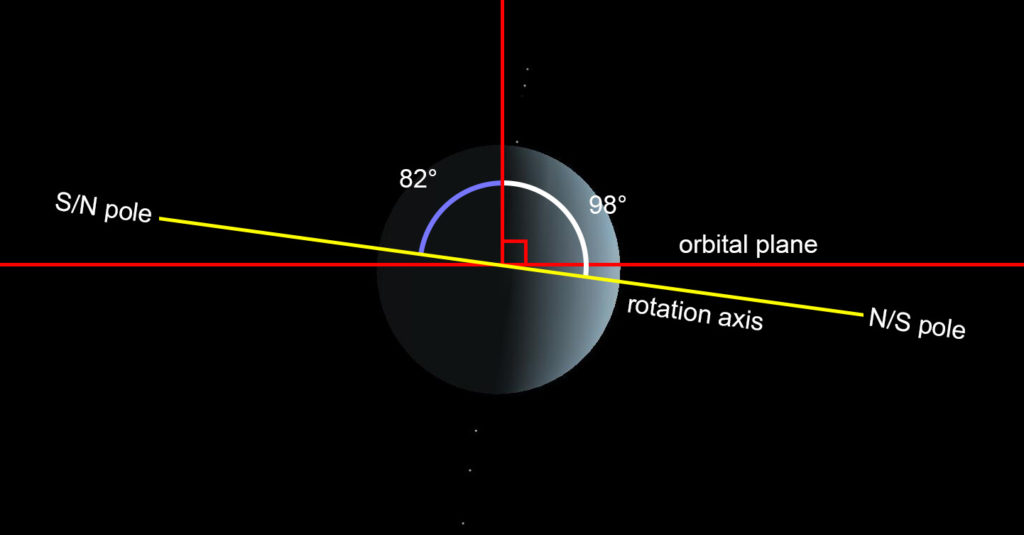
The other convention is to define the north pole by the right-hand rule. Namely, the north pole is the one about which the planet rotates counter-clockwise. If you curl the fingers of your right hand in the direction the planet is rotating, then your thumb defines the direction of the north pole. By this definition all planets rotate prograde, but some are tipped more than 90 degrees such that their north pole points below the plane of the solar system. For example, under this definition, Venus rotates prograde, but is tilted 177 degrees – its north pole is at the bottom. We will use this definition in this article.[3]
Before Voyager
The extreme distance to Uranus makes the study of this world rather challenging. Before the Voyager 2 flyby, all observations of Uranus were done from Earth, 1.79 billion miles away. Nonetheless, ground-based telescopes have revealed that Uranus has five moons. In order of increasing distance from the planet, they are Miranda, Ariel, Umbriel, Titania, and Oberon. The first two (Oberon and Titania) were discovered by William Herschel in 1787. Understandably, these are the brightest of the five. They can be seen with a moderate backyard telescope, but require very dark skies and considerable skill. Umbriel and Ariel are more challenging, but they too can be spotted. Miranda is the faintest of the five.[4]
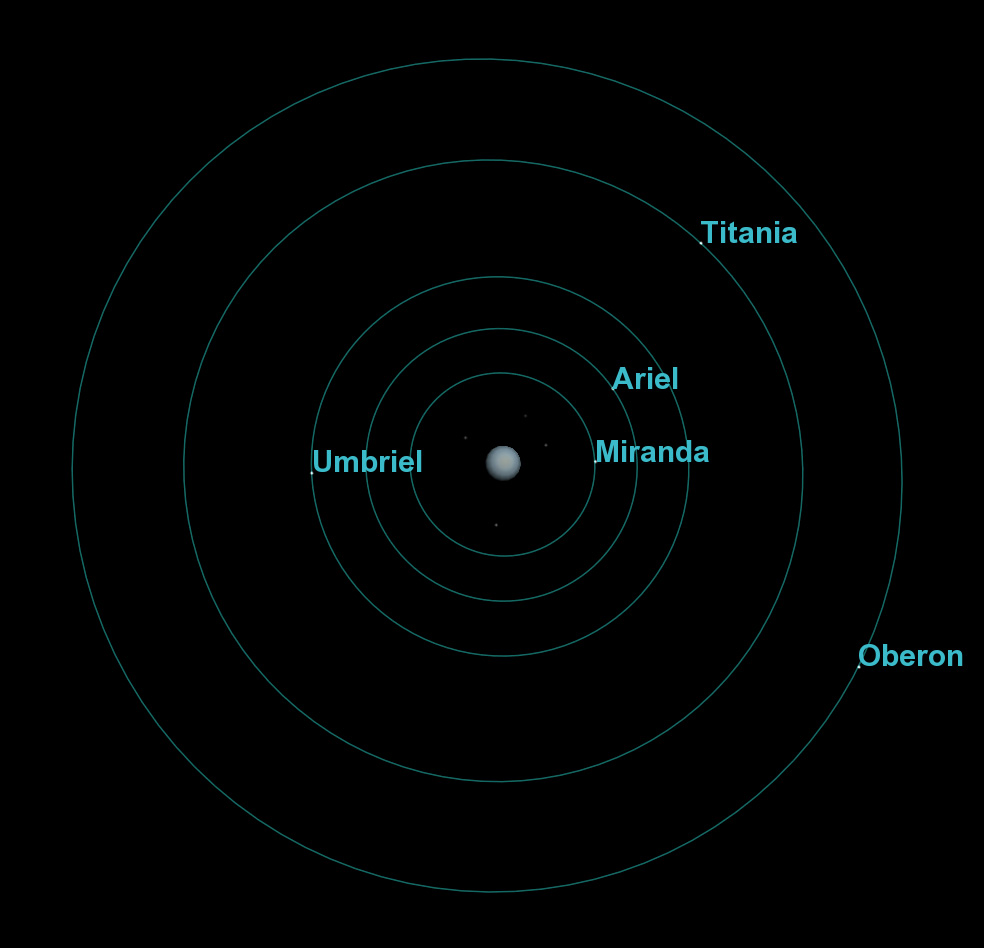
The five moons orbit around their planet’s equator. This is true for all large moons in the solar system except for Triton and Earth’s moon. But since Uranus is tilted 98 degrees, so are its moons. They orbit in the same direction that Uranus rotates, and in the same rotation plane, which is often at nearly 90 degrees relative to our line of sight on Earth. It is enjoyable to watch these moons orbit around Uranus night after night because we can often see them from almost directly “above” in contrast to Jupiter’s moons which always appear nearly edge-on. Of course, as Uranus orbits the sun, it too appears edge-on from our perspective twice every 84 years.
Another remarkable discovery was made using earth-based telescopes: Uranus has rings. Before 1977, Saturn was the only planet known to have rings. The rings or Uranus evaded detection until 1977 because they are far less dense and also darker than Saturn’s rings, making them very difficult to see. Even in 1977 they were not directly visible in our best telescopes. So how were they discovered? The answer involved an occultation of Uranus.
An occultation is the event of a planet crossing directly in front of a star, thereby blocking the star’s light. With modern technology, we can predict well in advance when these events are going to happen. As the planet Uranus drifts in front of a background star, the star does not wink out instantly because Uranus is not a solid sphere – it has a thick atmosphere. And so the outer, thinner atmosphere first crosses in front of the star, absorbing only some of its light. The star dims. Next the thicker atmosphere moves in front, and eventually the starlight is completely blocked. So, by watching the way in which the star fades, astronomers were hoping to learn something about the atmosphere of Uranus.
But strangely, before the disk of Uranus passed in front of the star, the star appeared to dim five times in succession. Then Uranus occulted the star, and when the star re-emerged from the other side, it again faded five times. Clearly, there were five obstacles both on the left and right side of Uranus and at equal distances, which were blocking the starlight. The observers recognized that a system of rings would produce such an effect.[5] Repeated observations confirmed this, and revealed the existence of four additional rings, for a total of nine. So, rather than a broad sheet of rings like Saturn’s A,B, and C rings, Uranus apparently has (at least) nine, thin, rope-like rings, much like Saturn’s F-ring.
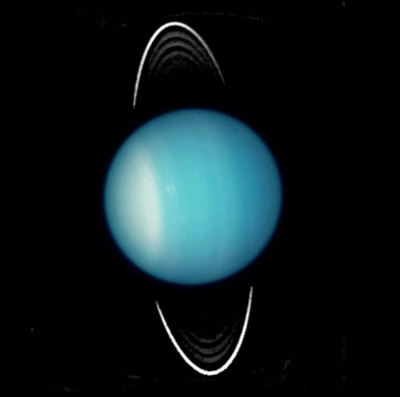
We now know that Uranus has a total of thirteen rings. The additional four rings are somewhat broader than the ropelike nine. The Voyager 2 spacecraft discovered two of these, completing the eleven rings of the inner group. The Hubble Space Telescope later discovered two rings at greater distance, which constitute the outer group: the ν (nu) and μ (mu) rings. The inner of these two (nu) is red in color, whereas the outer ring (mu) is blue. The inner 13 rings of Uranus are all a very dark and slightly reddish grey. The naming of these rings seems haphazard; they are assigned either a number or a Greek letter. In order of increasing distance from Uranus, the rings are ζ, 6, 5, 4, α, β, η, γ, δ, λ, ε, ν and μ.

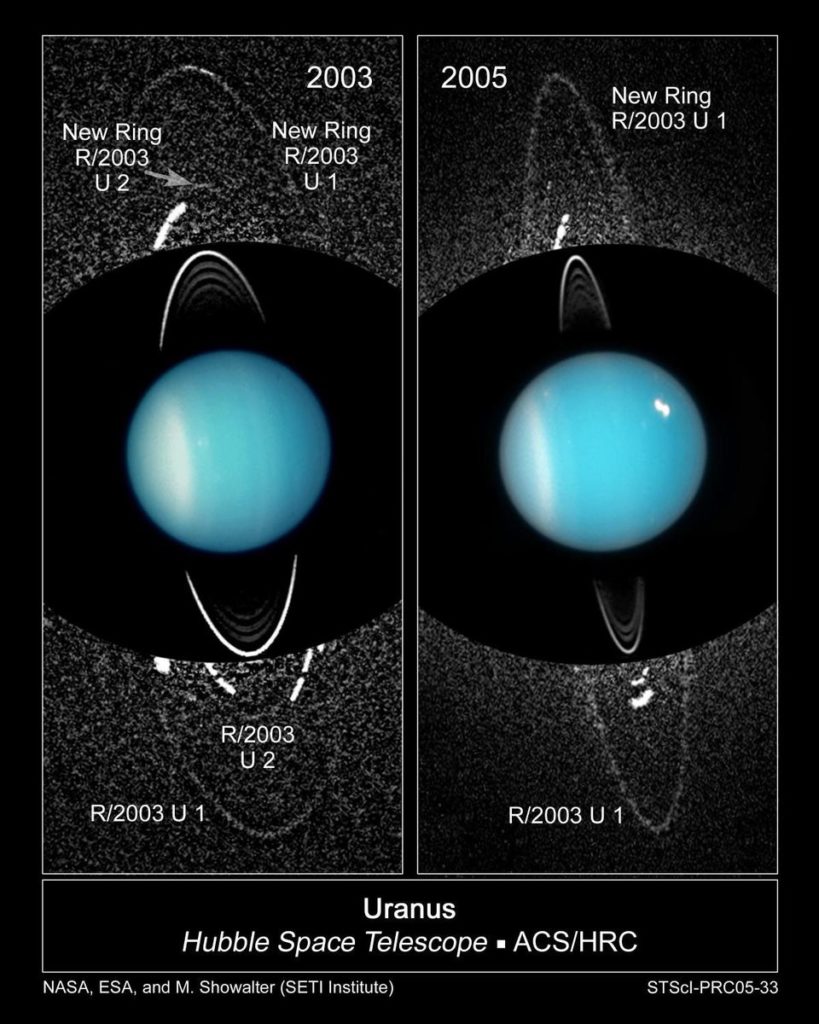
Voyager 2
Our knowledge of Uranus grew by volumes in January, 1986, thanks to the data collected by the Voyager 2 spacecraft. Recall, Voyager 1 and Voyager 2 were launched in the late 1970s and visited both Jupiter and Saturn. But only Voyager 2 had the proper trajectory to go on to visit Uranus.
On January 24, 1986, Voyager 2 flew by the planet Uranus revealing the planet in unprecedented detail. For the first time, we had direct images of the rings. And Voyager discovered two additional rings bringing the total up to eleven. We obtained the first (and only) closeup views of the five known moons. And Voyager 2 discovered ten more moons, never before seen from Earth.
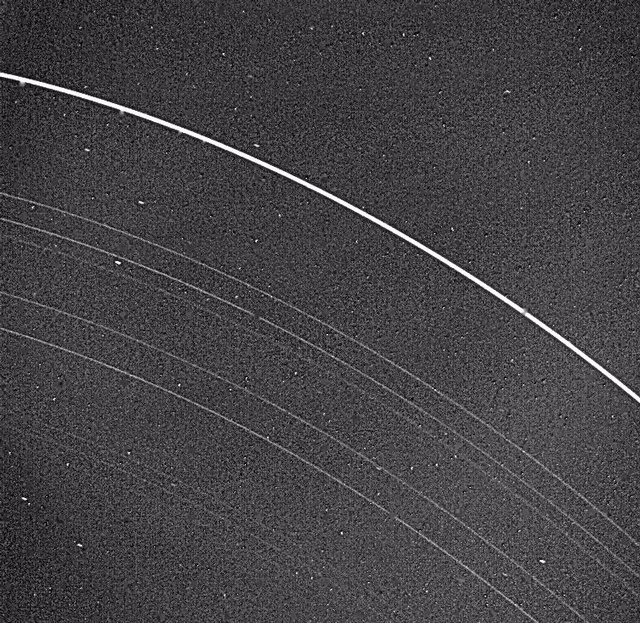
Although we know from Earth-based telescopes that Uranus often develops white clouds in its atmosphere, the planet was almost completely cloud-free during the Voyager 2 flyby. Unlike Jupiter and Saturn, no obvious belts or zones are apparent in visible light images of Uranus, however infrared images show that Uranus does have them.
Voyager 2 was also equipped with a device to measure magnetic fields. This confirmed that Uranus indeed has a strong magnetic field. This was quite surprising to many secularists; magnetic fields naturally decay over time and cannot persist for billions of years. However, the creation physicist Russ Humphreys predicted the strength of the magnetic field of Uranus back in 1984, based on the biblical age of about 6000 years. The Voyager 2 measurements confirmed Dr. Humphreys’ prediction.[6] In science, if you want to get the right answer, you need to take the Bible seriously.
Secular scientists often attempt to explain the existence of strong magnetic fields after (in their mind) billions of years by appealing to a magnetic dynamo model. The idea is that movement within a planet due to its rotation can somehow recharge a magnetic field over time. However, this model requires that the rotation axis is closely aligned with the magnetic poles; which is approximately true for Earth. But Voyager 2 found that the magnetic field of Uranus was not even remotely aligned with its rotation axis. In fact, a line connecting the magnetic poles does not pass through the center of Uranus. So as Uranus rotates, its magnetic field wobbles drastically, producing a corkscrew shape in space.
It was such a great start to the new year. We finally had images of Uranus in detail. Textbook writers eagerly began to replace the low-quality, blurry, Earth-based photographs, with these new stunning space-based images. Seven of the planets had now been visited by manmade spacecraft – a triumph of technology. Scientists would spend years studying the data from that brief flyby, and learn many new wonderful truths about God’s creation. To this day, Voyager 2 is the only spacecraft to have visited Uranus.
Yet, only four days after Voyager 2’s historic flyby, the space program was struck with a disastrous setback. The Space Shuttle Challenger exploded shortly after launch, and the lives of seven astronauts were tragically ended. The many previous successful space missions may have given people the impression that space travel is routine and safe. In reality, it is a very complicated feat of engineering in which thousands of systems must function properly and work together or the system fails. The destruction of Challenger dominated the news headlines for weeks, and largely overshadowed the new discoveries obtained by Voyager 2.
Only One Hemisphere
Thanks to the Voyager 2 flyby, we now have very high-resolution images of Uranus. These are still the sharpest images available, and are found in virtually all astronomy textbooks produced after the 1986 flyby. But technically, these images show only half of Uranus – its northern hemisphere (as defined by the right-hand rule). This is because Uranus was very near its northern summer solstice during the 1986 flyby. Hence, its north pole was pointed almost directly at the sun, and the southern hemisphere was in complete darkness. Of course, this isn’t a problem for mapping Uranus since it is essentially a featureless blue sphere; we expect the south pole to look about the same as the north pole. And recent Hubble images have confirmed this expectation.[7]
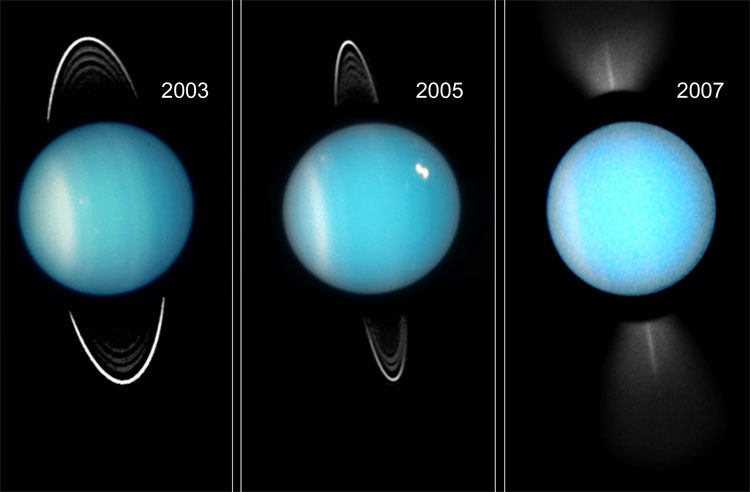
But it is an issue for the moons. Voyager 2 provided wonderful images of the five major moons of Uranus. These moons are tidally locked and rotate around Uranus’s equator. Hence, they also had only their northern hemispheres exposed to sunlight during the flyby. To this day, we only have images of the northern hemispheres of any of the moons of Uranus. To make a complete map of these moons, we could send another craft past Uranus during its (northern) winter solstice. This will occur in the year 2028 at which time the southern hemisphere of Uranus and its moons will be illuminated while the northern hemisphere is in total darkness. Alternatively, an orbiter could arrive up to 20 years later and still provide complete maps by imaging the moons over time. But keep in mind that it took Voyager 2 over eight years to get to Uranus, and that was with two gravitational assists (one from Jupiter, and one from Saturn). If we miss the upcoming window, it will be 84 years before another such opportunity arises. Currently, there are no plans in progress to send another spacecraft to Uranus.
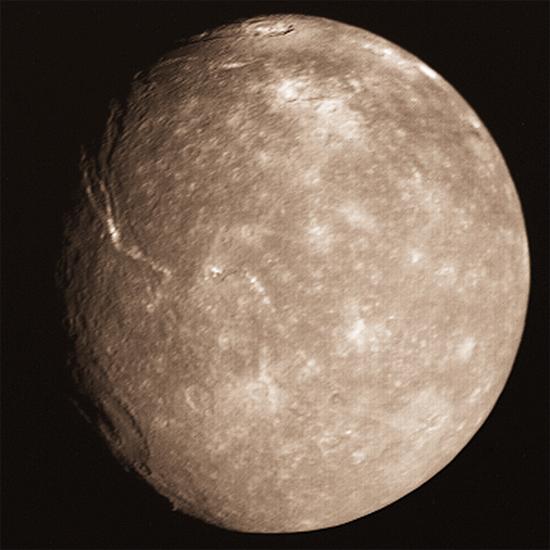
Fortunately, the Hubble Space Telescope can now provide Earth-based images of Uranus that allow us to see features in its atmosphere, albeit with less resolution than Voyager 2. This has allowed astronomers to watch the effects of seasonal changes on Uranus. Such images reveal storms and clouds, often on gargantuan scales, in contrast to the nearly featureless Voyager images. Ground-based observational technology has also improved drastically in the last three decades. However, neither ground-based observations nor Hubble can match the detailed images of the moons of Uranus provided by Voyager 2.
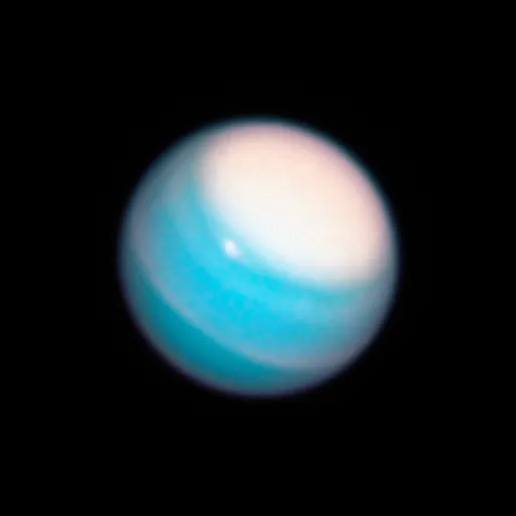
The Moons of Uranus
Of the four giant planets, Uranus has the least massive system of moons. Indeed, the largest moon of Uranus (Titania) is less than half the diameter of Earth’s moon. The five major moons of Uranus are large enough to be spherical, but still very small compared to the largest moons of Jupiter and Saturn. The major five moons are composed of roughly equal portions of rock and ice, except for Miranda which has more ice. The surface of Miranda is astonishing. It almost appears as if this little moon has been broken apart and reassembled incorrectly. It is amazing to see such detail on these little worlds which appear only as faint points in the largest Earth-based telescopes.
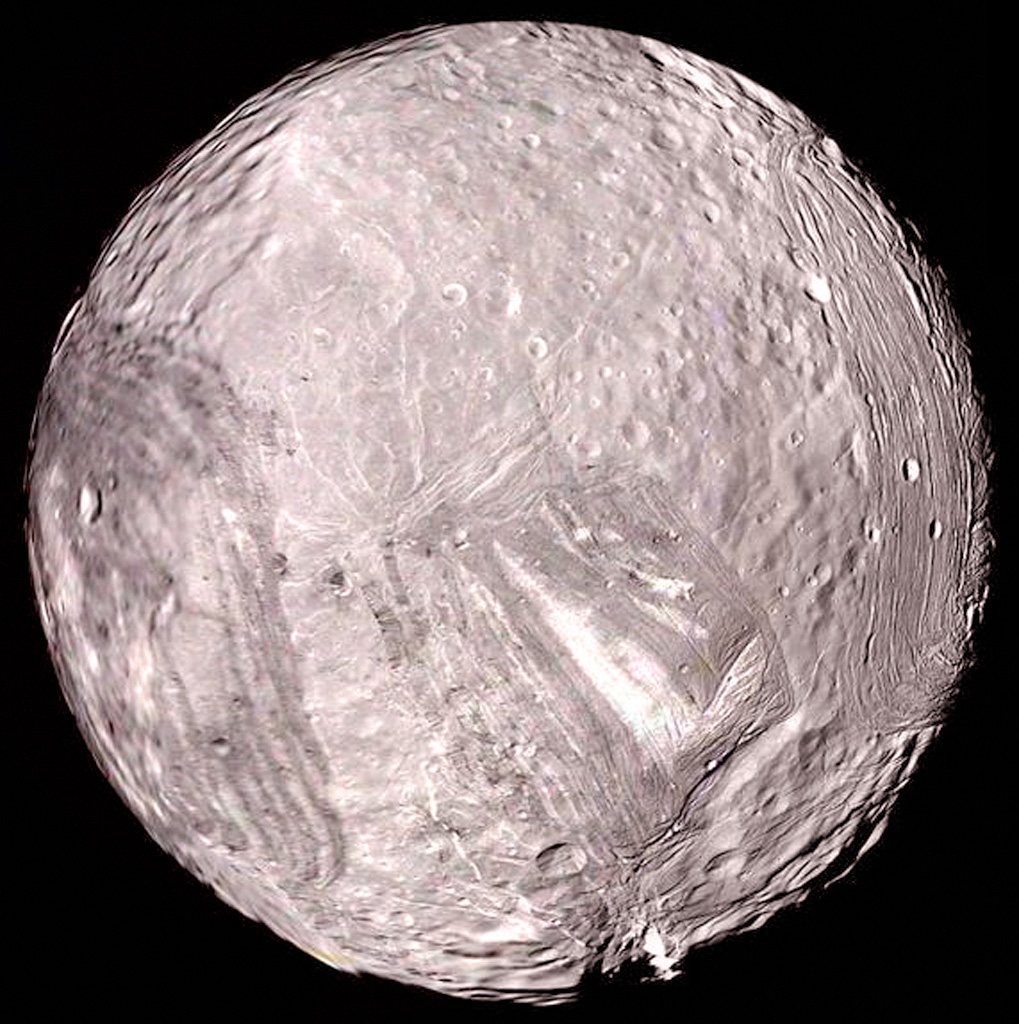

Voyager 2 discovered 10 additional moons – all of them closer to Uranus than Miranda. The innermost two moons are Cordelia and Ophelia. Cordelia orbits just inside Uranus’s epsilon ring, whereas Ophelia orbits just outside. They are shepherd satellites that keep particles constrained within the epsilon ring, just as Prometheus and Pandora patrol Saturn’s F-ring.[8] The epsilon ring is the brightest, most visible ring of Uranus.
The remaining eight moons discovered by Voyager 2 in increasing distance from Uranus are: Bianca, Cressida, Desdemona, Juliet, Portia, Rosalind, Belinda, and Puck. Of these, Puck is the largest with a diameter of about 100 miles. Three additional inner moons have been discovered in the years after the Voyager encounter. Cupid orbits in between Rosalind and Belinda, Perdita orbits in between Belinda and Puck, and Mab orbits within Uranus’s mu-ring, in between Puck and Miranda.

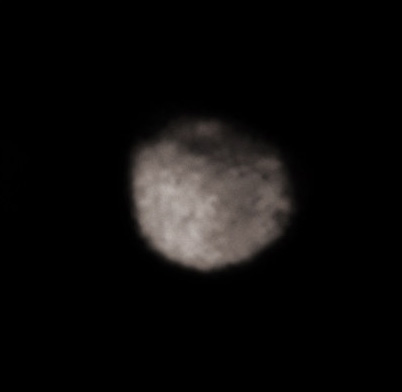
Students of literature will find the names of these moons familiar. Most of the moons of Uranus are named after characters from the plays of William Shakespeare. The remaining ones are named after characters from Alexander Pope’s humorous poem, “The Rape of the Lock.” This naming scheme is unique to Uranus, and honors the English heritage of William Herschel. Uranus was the first planet discovered by an Englishmen, so why not name its moons after characters from the greatest English playwright?
Amazingly, all of these 18 moons are regular – having nearly circular, prograde orbits in the plane of their planet’s equator.[9] Until 1997, Uranus was the only giant planet without any known irregular satellites. But astronomers have found nine additional moons from Earth-based observatories, bringing the current total up to 27. All nine additional moons orbit at a much greater distance than any of the inner or major moons. And all nine are irregular. Their orbits have higher eccentricities and inclinations than the inner moons. All but one of these nine orbit Uranus retrograde; the moon Margaret is the exception, and has one of the most eccentric orbits of the moons of our solar system. So we again see the pattern that is so prominent in the moon systems of the giant planets; inner moons orbit prograde and in the same plane thereby avoiding collision in the limited space, and outer moons do whatever they want.

Conclusion
What a wonderful time to be a Christian! We can explore planets that were completely unknown to the ancient world. And we have even sent spacecraft to image them. These discoveries continue to confirm biblical creation. Next we explore the “twin” of Uranus.
The table below lists the moons of Uranus in order of increasing distance from the planet. Blue indicates inner moons, yellow for the major five, green for retrograde irregular moons, and orange for the prograde irregular moon Margaret.
| order_dist. | moon | distance (miles) | period (d) | diameter (miles) |
| 1 | Cordelia | 30930 | 0.34 | 25 |
| 2 | Ophelia | 33420 | 0.38 | 27 |
| 3 | Bianca | 36770 | 0.43 | 32 |
| 4 | Cressida | 38390 | 0.46 | 50 |
| 5 | Desdemona | 38950 | 0.47 | 40 |
| 6 | Juliet | 39990 | 0.49 | 58 |
| 7 | Portia | 41070 | 0.51 | 84 |
| 8 | Rosalind | 43460 | 0.56 | 45 |
| 9 | Cupid | 46480 | 0.62 | 11 |
| 10 | Belinda | 46760 | 0.62 | 56 |
| 11 | Perdita | 47470 | 0.64 | 19 |
| 12 | Puck | 53440 | 0.76 | 101 |
| 13 | Mab | 60710 | 0.92 | 16 |
| 14 | Miranda | 80400 | 1.41 | 293 |
| 15 | Ariel | 118690 | 2.52 | 719 |
| 16 | Umbriel | 165470 | 4.14 | 727 |
| 17 | Titania | 270860 | 8.71 | 980 |
| 18 | Oberon | 362580 | 13.46 | 946 |
| 19 | Francisco | 2656980 | 266.56 | 14 |
| 20 | Caliban | 4492510 | 579.5 | 26 |
| 21 | Stephano | 4972210 | 676.5 | 20 |
| 22 | Trinculo | 5325770 | 758.1 | 11 |
| 23 | Sycorax | 7567680 | 1283.4 | 98 |
| 24 | Margaret | 8913570 | 1694.8 | 12 |
| 25 | Prospero | 10201670 | 1992.8 | 31 |
| 26 | Setebos | 10848520 | 2202.3 | 30 |
| 27 | Ferdinand | 12986650 | 2823.4 | 12 |
[1] At that time, the mirrors of reflecting telescopes were made of metal. Today we use glass (or sometimes plexiglass) coated with a thin metallic film: usually silver or aluminum.
[2] Herschel’s reason for studying double stars is interesting. He wanted to find evidence of parallax: the slight apparent shift of foreground stars relative to background stars as seen from Earth as it orbits the sun. The best way to detect this is to find two stars that have very different distances, but appear close together in the sky. Herschel initially assumed that this was the case for the double stars he catalogued; he assumed that they were merely optical doubles: stars that are not true binaries, but merely look close to each other. Contrary to Herschel’s assumption, most double stars are true binaries – two (or more) stars that orbit around their common center of mass, both at nearly the same distance from our solar system. Herschel’s attempt to find parallax failed. But his observations over time showed many of the binaries to be orbiting – a wonderful discovery. This demonstrated that Newton’s laws of gravity and motion applied in deep space, just as in our own solar system.
[3] There is a great deal of inconsistency in which convention is being used. I have found, for example, that most textbooks list Venus as rotating retrograde with a tilt of 3 degrees. This implies the use of the invariable plane definition. Yet, they will also list Uranus as rotating prograde, but tilted 97 degrees, which implies the use of the right-hand rule. I have followed this common tradition in this article series, despite its inherent inconsistency.
[4] I use a 14-inch telescope for most of my observations. Through it, I have seen four moons of Uranus, but I have not been able to spot Miranda (so far).
[5] The astronomers who discovered the rings of Uranus are James Elliot, Edward Dunham, and Jessica Mink.
[6] https://www.creationresearch.org/creation-planetary-magnetic-fields/
[7] At the present time, Uranus is approaching its winter solstice. So we are now seeing the opposite side of Uranus from Earth than was visible during the Voyager 2 encounter.
[8] Astronomers initially assumed that all nine of the rope-like rings of Uranus were surrounded by shepherding moons. But only the outer one (epsilon) is. The cause of the rope-like structure of the other eight rings is currently unknown.
[9] The orbits of all the inner and major moons lie within one half of a degree of the equator of Uranus – except Miranda. Miranda is inclined 4.2 degrees.

